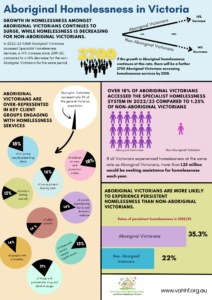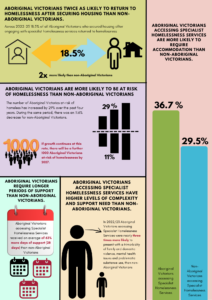What is the issue?
People in the private rental market face perhaps the most challenging market conditions in Victoria’s history. Decreasing rates of home ownership and chronic underinvestment in social housing has led to a significant growth in dependency on the private rental market. This additional competition has seen rents increase, with those on a median income earning households now spending over 30% of their income on rent, which is the widely accepted definition of housing stress.
Compounding the issues Aboriginal Victorians experience in accessing the private rental market is the systemic racial and cultural discrimination on behalf of landlords and real estate agents.
Additional barriers for many Aboriginal and Torres Strait Islander People in attaining a private rental property include a greater reliance on income support or low salaries to get by, absences of rental histories, and the large size of families. These barries are leading to a greater likelihood of being priced out of the market.
What are we doing?
Goal 3 of Mana-na woorn-tyeen maar-takoort, Every Aboriginal Person Has a Home is to ‘Open doors to home ownership and private rental’.
The Aboriginal Private Rental Assistance Program (APRAP)
In response to Mana-na woorn-tyeen maar-takoort, in November 2020, the Victorian Government committed over $4million in funding over two years for the Aboriginal Private Rental Assistance Program (APRAP) to be implemented in five areas. These were Northeast Metro Melbourne, Mallee, Western metro, Loddon and Inner Gippsland. In 2023 the Government committed a further $5.4 million to expand the program to include a further four areas: Bayside, Outer Gippsland, Goulburn and Brimbank Melton.
APRAP is a preventative intervention that provides holistic support to households experiencing or at risk of homelessness. It includes establishing an Aboriginal rent brokerage and subsidy program, bond subsidies, and models to manage tenants at risk.
Two key principles highlighted in Mana-ana worn-tyeen maar-takoort which are reflected in the Aboriginal Private Rental Assistance Program.
- Increase uptake of Private Rental and
- Build a systems-based partnership between the mainstream and Aboriginal housing and homelessness systems.
APRAP is intended to prevent or end homelessness and housing crisis experienced by Aboriginal households by:
- Rapidly rehousing people capable of sustaining private rental after some initial support
- Supporting at risk households to sustain affordable and appropriate housing in the private rental market
- Assisting people who currently live in crisis, transitional or social housing to become independent in the private rental market if appropriate and sustainable.
Aboriginal Private Rental Access in Victoria “Excluded from the Start” Project
Goal 3.1.1 of Mana-na worn-tyeen maar-takoort is to work with the Commissioner for Residential Tenancies to investigate apparent discrimination against Aboriginal people in the private rental market.
Swinburne University of Technology researchers were contracted by the Consumer Policy Research Centre, on behalf of the Office of the Commissioner for Residential Tenancies, Victorian Legal Aid and Aboriginal Housing Victoria to conduct research into discrimination and other barriers faced by Aboriginal Victorians trying to access the private rental market. From the report, ‘Aboriginal Private Rental Access in Victoria: “Excluded from the Start”’, the Commissioner for Residential Tenancies identified 14 Recommendations to address the barriers that the Victorian Aboriginal community faces in accessing the private rental market including practical actions to improve access, improve the development and dissemination of effective rental information, the wider availability of support, measure to address discrimination and improve dispute resolution.
The 14 recommendations were endorsed by the VAHHF IWG. The Office of the Commissioner for Residential Tenancies, Dr Heather Holst , has convened an Aboriginal Private Rental Access Project Committee to progress the recommendations.
Our partnership with the Real Estate Institute of Victoria (REIV)
The Commissioner for Residential Tenancies and AHHF secretariat have met with the Real Estate Institute of Victoria (REIV) to commence building stronger relationships with the peak body and its members. As part of these discussions the below two initiatives have commenced:
- (1) cultural change through campaigning with landlords and real estate agents to shift the perception of Aboriginal tenants to be acknowledged and viewed as ‘good tenants’. In conjunction with the Office of the Commissioner for Residential Tenancies and in partnership with REIV, an Aboriginal Cultural Safety training module will be introduced and delivered to real estate agents throughout Victoria via REIV’s monthly webinars with their members. The goals of the training models are: To be more culturally safe, Reduce access barriers for Aboriginal people when applying for a property and Deliver culturally safe tenancy management services. The training module will be provided and delivered by The Victorian Aboriginal Community Services Association Ltd (VACSAL)
- (2) increasing the number of Aboriginal real estate agents to assist in changing this perception and opening doors to the market. Working again with REIV, 100 ‘traineeships’ of the CPP41419- Certificate IV in Real Estate Practice Training have been made available for Aboriginal and Torres Strait Islander people living in Victoria. This is the entry level qualification needed to work in Real Estate. These traineeships valued at $600,000 funded by REIV will be commenced and continued throughout 2024 with the aim of having 100 Aboriginal and Torres Strait islander people enter the Real Estate industry by July 2025.
- (3) Government working with the REIV, the Property Council, and AHV to commission the research and design of a behaviour change program.



Social housing
What is the issue?
Since 2007, Victoria’s population has grown by around one million people. Victoria’s Aboriginal population (which is currently 66,000) is also growing and is expected to continue to grow by 2.5%-2.8% (approximately 220 people per year). Victoria’s social housing stock has not grown in line with this population growth, instead hovering between 64,000 and 65,000 units since 2007. This constitutes approximately 3% of Victoria’s housing stock, which is between 1% and 2% lower than the national average.
Currently, 22% of Aboriginal Households live in social housing (with an additional 20% on the Victorian Housing Register waiting to be housed) compared to 0.9% of Victoria’s non-Aboriginal population. Under conservative assumptions, without further investments, it is projected that there will be a shortfall in social housing units of 2,488 by 2026, 3,700 by 2031, and 5,085 by 2036. These projections suggest that without these additional social housing units, the rates of Aboriginal people being displaced from their communities and being at risk of homelessness will continue to grow. For example, it is estimated that if other settings remain unchanged, by 2036 an additional 20,000+ Aboriginal Victorians will be homeless or at risk of homelessness.
What are we doing?
Objective 2.2 of Mana-na woorn-tyeen maar-takoort is to build 5000+ social housing properties by 2036 with objectives 2.2.1 and 2.2.2 providing further detail and articulating how this might be achieved. For example, objective 2.2.2 argues that it is critical that as part of all Government housing funds and initiatives, Aboriginal specific targets are included with specific resources directed towards supporting Aboriginal communities.
Further, through the work of members, the AHHF will continue to provide opportunities for ACCOs and Traditional Owner groups to build their social housing portfolio and advocate for more funding to help grow this emerging sector. The AHHF is committed to facilitating the creation of an Aboriginal community housing sector that is sophisticated, self-determined and better able to respond and meet the needs of Aboriginal Victorians.